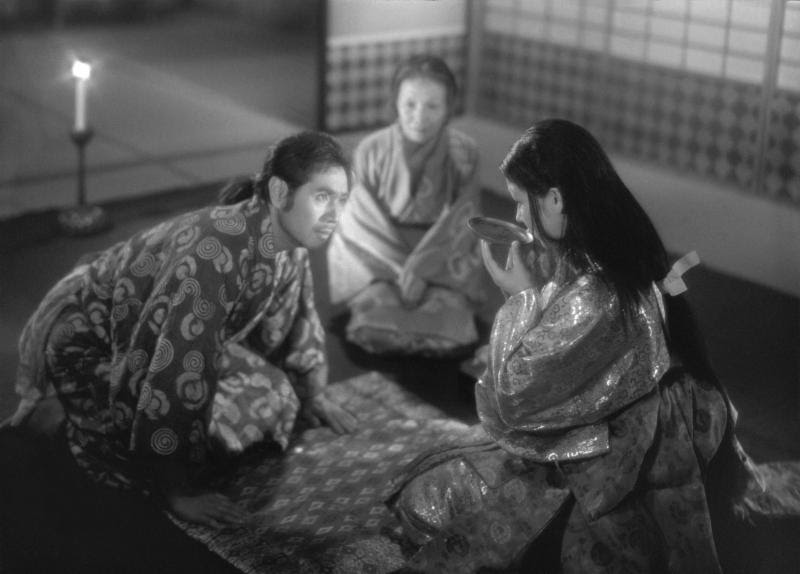‘Ugetsu’ is an Essential, Beautiful Haunt
Masayuki Mori and Machiko Kyô as the potter Genjuro and his client Lady Wakasa, in the ghost film “Ugetsu,” by Japanese director Kenji Mizugochi.
March 2, 2017
Perhaps no film in the history of international cinema is more haunting than Kenji Mizuguchi’s masterful 1953 ghost film “Ugetsu.” Ostensibly, modern movies concerned with ghosts are filled to the brim with fright and angered spirits acting out of vengeance. “Ugetsu” fits none of these descriptions; instead, the film relishes in a key component of all spectral cinema — the uncanny — and portrays the lilting beauty and sophistication ghost stories can hold.
Set in the midst of civil war in 16th century Japan, the plot focuses on a potter named Genjuro (Masayuki Mori). Genjuro utilizes the impacts of war to make good money, which he uses to support his wife, child and relatives. When he is required to travel far away from his family for a new business deal, his pottery prospers with a mysterious client named Lady Wakasa (Machiko Kyo). She eventually invites Genjuro to stay at her mansion, where she lives alone because soldiers attacked and killed all its other residents. He quickly learns that the mansion is haunted by the ghost of the lady’s father.
It is through Genjuro’s almost celestial bond with Lady Wakasa that many of the film’s technical marvels shine brightest. The performances showcase delightful chemistry, a bright style of black-and-white cinematography and a subtle traditional Japanese score which engulfs the listener in tradition and culture.
These elements provide a great deal of beauty to “Ugetsu,” and subsequently an uncanniness for a war film. An extremely rare-breed piece that explores the prospects of success during situations of conflict, the film portrays an old moral — success from ambition comes at the price of suffering.
Alongside Genjuro’s story, the narrative scrutinizes a subplot revolving around his brother-in-law Tobei (Eitaro Ozawa) and Tobei’s wife Ohama (Mitsuko Mito). Tobei’s life both contrasts and mirrors the opulence of his brother-in-law’s life. This comparison serves as a foil for the comfort of attaining wealth and a memento of what is left behind when ambition takes over — like Genjuro’s eventual leaving of his wife. Tobei’s own claim to fame revolves around the abandonment and decay of Ohama.
The theme of loss begotten by ambition is complemented by the visual motifs, ranging from foggy boat rides to the soundtrack. Combining components of homeliness with unsettling sensations leads to sequences that are both visually and emotionally jarring. A simple shot of a village landscape that bookends the beginning and end of the film stakes this claim. The feeling one has during this shot at the beginning of the film is radically transformed by the finale.
This leads into the overarching importance of “Ugetsu” — its uncanniness extends from the narrative of the movie and into the world. Its theme of ambition and prosperity correlating with regret and adversity is in direct response to a post-WWII Japan, the society the film’s symptomatic messages are often directed at. But moving beyond Japanese history, it also wholly represents human nature.
The distinctly Japanese score is notably akin to Western symphonic noise in several dramatic instances in the narrative — perhaps connecting the story to places outside of Japan. Its spectral storytelling also might have influenced more contemporary Japanese spirit films with similar visual and narrative styles, such as “Ringu” and “Spirited Away.”
With its historical significance and ongoing influence in Japanese media, “Ugetsu” is an essential watch for any fan of international cinema. Like the ghost it portrays, the film itself is a haunting reminder of the lives of the past and how the familiar can become strange.
“Ugetsu” will be playing in an all-new 4K restoration at the New York Film Forums at 215 Park Ave. S from March 3-9.
Email Matthew Holman at [email protected].

























































































































































